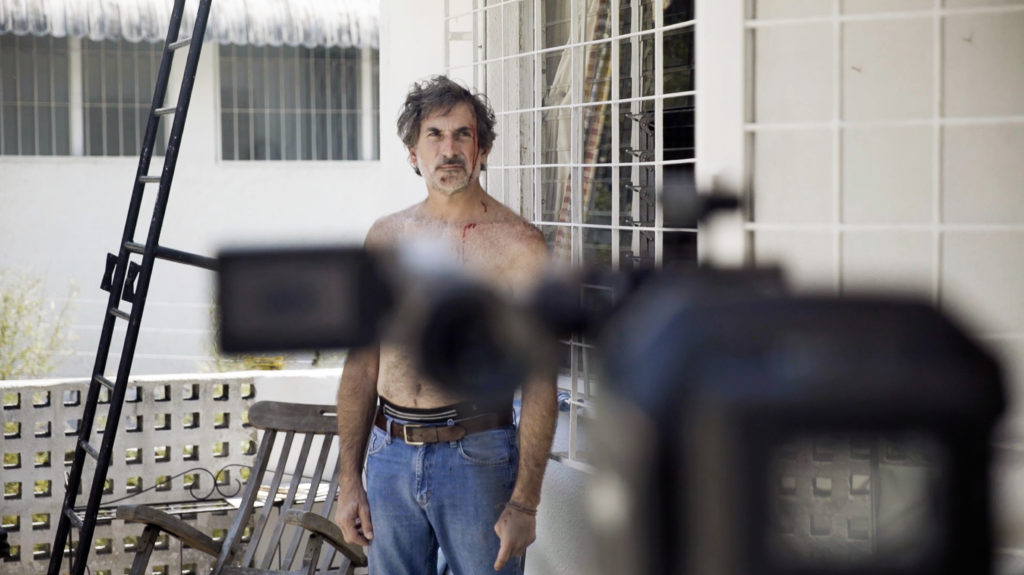We’ve covered seasonal nonfiction film series The DocYard many times before, so I’ll skip the overlong introduction, mention some vital details, and leave the rest of the space for the reviews. (1) The Spring 2022 program takes place at the Brattle Theatre on some Mondays through May 16, (2) at press time two shows have already occurred and six are still to come, and (3) all films are screened virtually as well, but only for those who purchase a season pass (see thedocyard.com), which at $49 is rather affordable even just for the six movies that remain. The reviews below have been arranged in the order the films are scheduled. —Jake Mulligan

Rock Bottom Riser
Directed and edited by Fern Silva. US, 2021, 70 minutes.
Images of Hawaiian volcanoes recur throughout Rock Bottom Riser, the feature debut of Fern Silva, who already has fifteen years’ worth of experimental ethnography shorts to his credit. These shots provide a marvelous look at lava’s molten glow—nature’s most dazzling yet most dangerous color—and its viscous bubbles, and its unstoppable flow. Here nature, and therefore the earth itself, is alive, moving, growing, transforming. One of these volcanoes is Mauna Kea, the most sacred mountain in indigenous Hawaiian culture as well as the site of several telescopes, plus the proposed Thirty Meter Telescope, which provides the island with jobs and tourism. It’s America in a microcosm: it symbolizes our strive for enlightenment and entry into global capitalism, but also denotes settler colonialism and forces us to question what we mean when we talk about “progress.”
Rock Bottom Riser addresses this question elliptically, through both the telescope and adjacent issues (such as Dwayne “The Rock” Johnson’s role as King Kamehameha in an upcoming Robert Zemeckis film), featuring narrated passages, landscape shots, found footage, interviews, and some scripted scenes as well (including a slightly-altered recreation of a scene from Frederick Wiseman’s High School, 1968). Silva’s short-form practice is perhaps too evident here—the film’s 70 minutes feel long, and its sequencing often feels random. Still, consider the value of scenes like one where two men demonstrate a remarkable but inane ability to blow smoke rings in a vape shop named “Volcano.” It’s an emphatic demonstration of how the environment is destroyed puff by puff in the service of capital, living earth transformed into something deadening, and few directors would have the courage or ability to present it with the depth and intricacy afforded here. [★★★] —Forrest Cardamenis
Rock Bottom Riser screened at the Brattle Theatre on February 21.

El Father Plays Himself
Directed by Mo Scarpelli. Italy/UK/US/Venezuela, 2020, 105 minutes.
The generation that grew up with “making of” documentaries is now of age, so perhaps it’s no surprise to see nonfiction features that embrace and reconfigure the form. Mo Scarpelli’s El Father Plays Himself, shot while her partner Jorge Thielen Armand was making La Fortaleza (2020), is the latest to make such an effort, and reveals the autobiographical components of the latter film: El Father, like his character in La Fortaleza, is a heavy drinker, and his character’s history of working in mines is based on his own. In a typical behind-the-scenes featurette we might expect this parallel to be alluded to and addressed through interviews, so comparisons between this quiet yet dramatically propulsive film and DVD-era extras are insufficient.
Indeed, Scarpelli leans into rather than avoids the uncomfortable, sometimes ethically suspect elements of La Fortaleza’s process. Thielen Armand wants to spend quality time with his father and to make a film, and the result is a production that all but requires El Father to indulge in his biggest vice—much to the chagrin of the cast and crew, who occasionally threaten to quit. In contrast, Thielen Armand is generally quite stoic, and watching him work his father’s alcoholism into the film results in a number of compelling scenes where Thielen Armand tries to schedule El Father’s drinking. What emerges is an unexpected but moving portrait of a son’s attempt not necessarily to fix but to justify his father’s vices, captured with an intimacy that could only be attained by the work of close family, and certainly not by anyone trying to sell discs. [★★★] —Forrest Cardamenis
El Father Plays Himself screens at the Brattle Theatre tonight, March 7, at 7pm.

A Thousand Fires
Directed by Saeed Taji Farouky. 2021, France/Netherlands/Palestine/Switzerland, 90 minutes.
Awash in hazy brown tones, A Thousand Fires tells the story of an oil-drilling Myanmar family from the perspective of a flyby observer. The story takes place in the Magway region and centers on the couple Htwe Tin and Thein Shwe, who put in hard physical work manually extracting oil, and their soccer-playing teenage son Zin Ko Aung. They seek advice from a fortune teller, who reads their palms and tells them that they have good karma, but that hard work must continue. “Mrs. Htwe Tin, your lines say you have good luck in the oil business, but you won’t achieve it without sweat.” Moreover, the palmist says Zin Ko Aung is “the boss” of the family—the teenager aspires to be a star on the soccer field, and his parents are counting on his talent to propel him to a life beyond oil. The film captures the family’s conversations, spirituality, and close-ups of the work they do, creating an intimate atmosphere. There are no distractions, and the director takes a restrained approach—A Thousand Fires is about one family’s tenacity and hope, a film stark in its simplicity. [★★★★] —Olivia Deng
A Thousand Fires screens at the Brattle Theatre on Monday, March 21, at 7pm.

“Three Shorts from Morgan Quaintance (2020-2021)”
Program includes South (UK, 2020, 28 minutes), A Human Certainty (UK, 2021, 20 minutes), and Surviving You, Always (UK, 2021, 18 minutes).
First, to address the qualities that link all these works: Quaintance films much of his shorts on a Bolex camera, which can only shoot 20 seconds of footage at a time. The result is that his movies are essentially collaged, the product of sorting through a disparate collection of images and figuring out what might link them together. Part of that collage material is archival footage, audio, and photography, all liberally interspersed throughout. Surviving You and Human Certainty both have narration in the form of subtitles, which frankly is one of the things that makes them less significant than South, in my book. In particular, the narration in Human Certainty drove me crazy; while it’s necessary in order to grasp the general theme—a connection drawn between the end of a relationship and the end of all things that is death—it moves beyond evocative and ends up somewhere in the realm of insipid. But sorry about the breakup!
South is the longest of the films, and the best of them. It’s as fragmentary as the others, but less obvious in the way it’s put together. That is not to say it’s opaque, but instead manages to maintain a sly mysteriousness. Quaintance collages together a variety of liberatory struggles from across the past century, primarily civil rights movements involving Black Panthers, Young Patriots, and anti-apartheid organizing in the UK. But if most films about past struggles for emancipation underline the power of this kind of work, Quaintance tempers it with the nervousness that comes from being unable to shake the sense of our more tentative, private selves—selves that can never quite achieve perfect alignment with the demands of collective action. The film begins with footage of a woman coaching singers in a black church, the same woman who in fact taught Quaintance’s grandmother to sing, the individual voice’s primacy leading into the archival footage. But the images of people’s faces at assorted rallies and marches are cut on the quick, and set to the sounds of zipping strings as if it were a trailer for a horror film. We hear civil rights and welfare rights organizer Peggy Terry asked what it is that made her develop a sense of consciousness as opposed to other (poor, Southern, white, etc.) family members. “I don’t know,” she responds, “I truly don’t. I wish I knew.” So when the short closes with illuminated MRI scans of Quaintance’s own brain, set to Barry Manilow crooning “Could this be the magic at last?,” we do wonder what the answer might be. Whatever it is, it probably exists somewhere in the alien realm of soft tissue matter that—as a television doctor might say—produces the ultimate mystery: ourselves. [★★★] —Hannah Kinney-Kobre
“Three Shorts from Morgan Quantaince (2020-2021)” screens at the Brattle Theatre on Monday, April 4, at 7pm.

After Sherman
Directed by Jon-Sesrie Goff. US, 2022, 88 minutes.
Cross-generational memories and fractured histories of where you came from and how you can never escape your roots, let alone some of the biggest tensions in the history of the United States, are at the center of After Sherman. The coastal region of Georgetown, South Carolina is loaded with a mix of pride, joy, resentment, and trauma. These feelings, not without their natural contradictions, have sustained with both current and former residents. The materials of Goff’s film are both prescient and personal, presenting archives of family photos, home movies, analog recordings, and on-camera testimonials that depict a resilient and upstanding community of Black Americans whose history with the region remains inextricable from slavery, Jim Crow laws, and the looming threat of the Klu Klux Klan. The director’s father, a pastor, takes over duties at nearby Charleston’s Mother Emanuel AME Church in the horrific aftermath of a mass-shooting by a white supremacist. After Sherman shows the futility of our “collective” history where the burden of presenting the fuller, truer perspective of America’s violent past rests on the oppressed and their lineage, while the oppressors spin their own tales. These cycles of anti-black violence push Goff to question both his father and others about how their community can forgive, when that has already failed to halt ongoing cycles of racism and terror. There are no easy answers, but After Sherman also shows the virtue in looking back, and how it may help us to foresee the uncertain future. [★★★★] —Caden Mark Gardner
After Sherman screens at the Brattle Theatre on Monday, April 25, at 7pm.
For season passes and more information about both the DocYard series and the films playing as part of the Spring 2022 program, see thedocyard.com. For tickets to individual screenings, see brattlefilm.org.
Other upcoming shows include What We Leave Behind (May 9, 7pm) and Nuclear Family (May 16, 7pm), which will be reviewed in a future issue of DigBoston.
Dig Staff means this article was a collaborative effort. Teamwork, as we like to call it.

